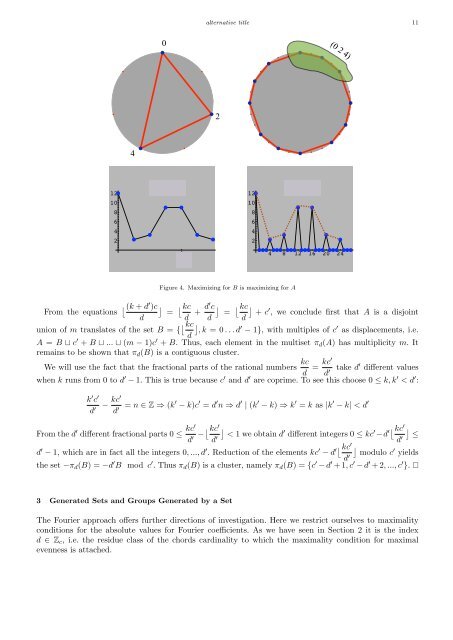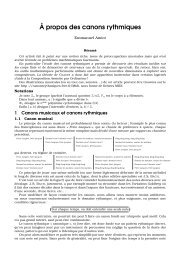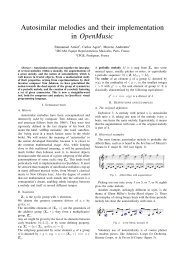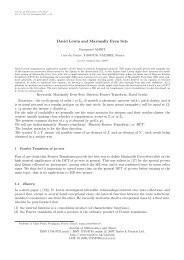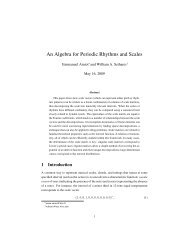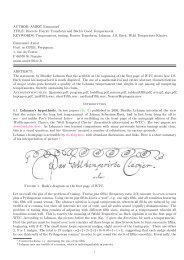Emmanuel Amiot Modèles algébriques et algorithmes pour la ...
Emmanuel Amiot Modèles algébriques et algorithmes pour la ...
Emmanuel Amiot Modèles algébriques et algorithmes pour la ...
You also want an ePaper? Increase the reach of your titles
YUMPU automatically turns print PDFs into web optimized ePapers that Google loves.
12<br />
10<br />
8<br />
6<br />
4<br />
2<br />
4<br />
0<br />
ME7,3<br />
4<br />
alternative title 11<br />
2<br />
12<br />
10<br />
Figure 4. Maximizing for B is maximizing for A<br />
8<br />
6<br />
4<br />
2<br />
ME28,12<br />
(0 2 4)<br />
4 8 12 16 20 24<br />
From the equations (k + d ′ )c<br />
kc<br />
=<br />
d d + d′ c<br />
kc <br />
= + c ′ , we conclude first that A is a disjoint<br />
d d<br />
union of m trans<strong>la</strong>tes of the s<strong>et</strong> B = { kc <br />
, k = 0 . . . d ′ − 1}, with multiples of c ′ as disp<strong>la</strong>cements, i.e.<br />
d<br />
A = B ⊔ c ′ + B ⊔ ... ⊔ (m − 1)c ′ + B. Thus, each element in the multis<strong>et</strong> πd(A) has multiplicity m. It<br />
remains to be shown that πd(B) is a contiguous cluster.<br />
We will use the fact that the fractional parts of the rational numbers kc<br />
d<br />
= kc′<br />
d ′ take d′ different values<br />
when k runs from 0 to d ′ − 1. This is true because c ′ and d ′ are coprime. To see this choose 0 ≤ k, k ′ < d ′ :<br />
k ′ c ′ kc′<br />
−<br />
d ′ d ′ = n ∈ Z ⇒ (k′ − k)c ′ = d ′ n ⇒ d ′ | (k ′ − k) ⇒ k ′ = k as |k ′ − k| < d ′<br />
From the d ′ different fractional parts 0 ≤ kc′ ′<br />
−kc<br />
d ′ d ′<br />
kc ′<br />
< 1 we obtain d ′ different integers 0 ≤ kc ′ −d ′<br />
d ′<br />
<br />
≤<br />
d ′ − 1, which are in fact all the integers 0, ..., d ′ . Reduction of the elements kc ′ ′<br />
− d ′kc<br />
d ′<br />
<br />
modulo c ′ yields<br />
the s<strong>et</strong> −πd(B) = −d ′ B mod c ′ . Thus πd(B) is a cluster, namely πd(B) = {c ′ − d ′ + 1, c ′ − d ′ + 2, ..., c ′ }. <br />
3 Generated S<strong>et</strong>s and Groups Generated by a S<strong>et</strong><br />
The Fourier approach offers further directions of investigation. Here we restrict ourselves to maximality<br />
conditions for the absolute values for Fourier coefficients. As we have seen in Section 2 it is the index<br />
d ∈ Zc, i.e. the residue c<strong>la</strong>ss of the chords cardinality to which the maximality condition for maximal<br />
evenness is attached.


